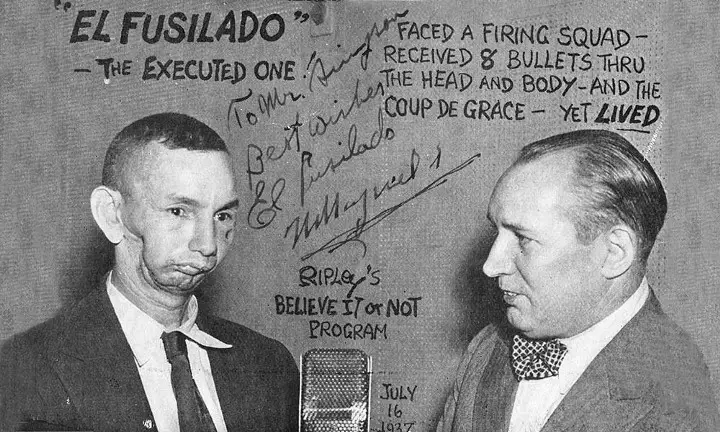 ur bodies are full of surprises, and to survive, the body of an organism can sometimes defeat the most impossible odds. From a medical perspective, no one should survive one bullet to the head, although throughout history there have been a handful of cases where people were shot twice in the head and managed to survive but at the cost of major brain injuries.
ur bodies are full of surprises, and to survive, the body of an organism can sometimes defeat the most impossible odds. From a medical perspective, no one should survive one bullet to the head, although throughout history there have been a handful of cases where people were shot twice in the head and managed to survive but at the cost of major brain injuries.
Believe it or not, there is a man in history that did “the impossible” by surviving an execution where nine bullets were shot simultaneously at him and somehow survived.
The Mexican Revolution
Wenseslao Moguel, famously known in the 1930s as “El Fusilado” translating to “The Executed One,” is the man who beat the odds and even outplayed death at its own game. In 1915, during the Mexican revolution, Moguel was a soldier fighting on the side of Pancho Villa or the revolutionary force. 1915 was the same year Pancho Villa was defeated and Moguel with some other comrades of his were forced to the last stand that ended up with most of the left troops surrendering.

The Mexican revolution was vicious and that is why all of the prisoners taken by either side would be executed. Moguel was the last one to be executed from his squad. The soldiers would be placed at a wall where a firing squad made up of eight men would take the shot whilst trying to aim at the head. Once the eight shots were fired at the same time, Moguel dropped on the floor but was still breathing, so the execution commander shot him a ninth time straight in the head to make sure he was dead.
The executed one
Even if most of the shots went to his head, the ninth one should have been 99.99% lethal as it was taken point-blank. Seeing that he was still alive, Moguel faked his death by holding his breath. Once the enemy soldier’s left, he ran away on his own two feet looking for help. He entered the Church of Saint James Apostle in downtown Santiago Tequixquiac where he found a parishioner that took the bullets out of him and stitched his wounds.

The Parishioner was amazed at how lucky he was to survive nine shots, so he hid him until 1924 when the Mexican revolution ended. Not only did Moguel survive nine shots, but he had no brain damage.
In 1930, Moguel migrated to the United States the look for a better life, although his story became quite popular in Mexico, nobody really knew him in the United States. People started asking questions about what happened and how he had ended up with his face so disfigured. That is when he started telling his famous story and the word quickly got out.

It wasn’t until 1937 that Moguel really became popular around the United States with his first appearance on “Ripley’s Believe It or Not” radio show in Cleveland, Ohio. Moguel became so loved by the audience that NBC started a tour around the United States for people to see this hero live. Within the tour, his wounds would be shown The executed one attracted the attention of producers all over America as people really saw him as a true hero.
Despite the major injuries suffered due to the execution, Moguel managed to live to the age of 85. He died in Mexico in 1975 due to natural causes. Interestingly enough, in 2008 the British band Chumbawamba released a song about the attempted execution of Moguel titled “El Fusilado.”
Avid Writer with invaluable knowledge of Humanity!
Upcoming historian with over 30 million views online.
“You make your own life.”





